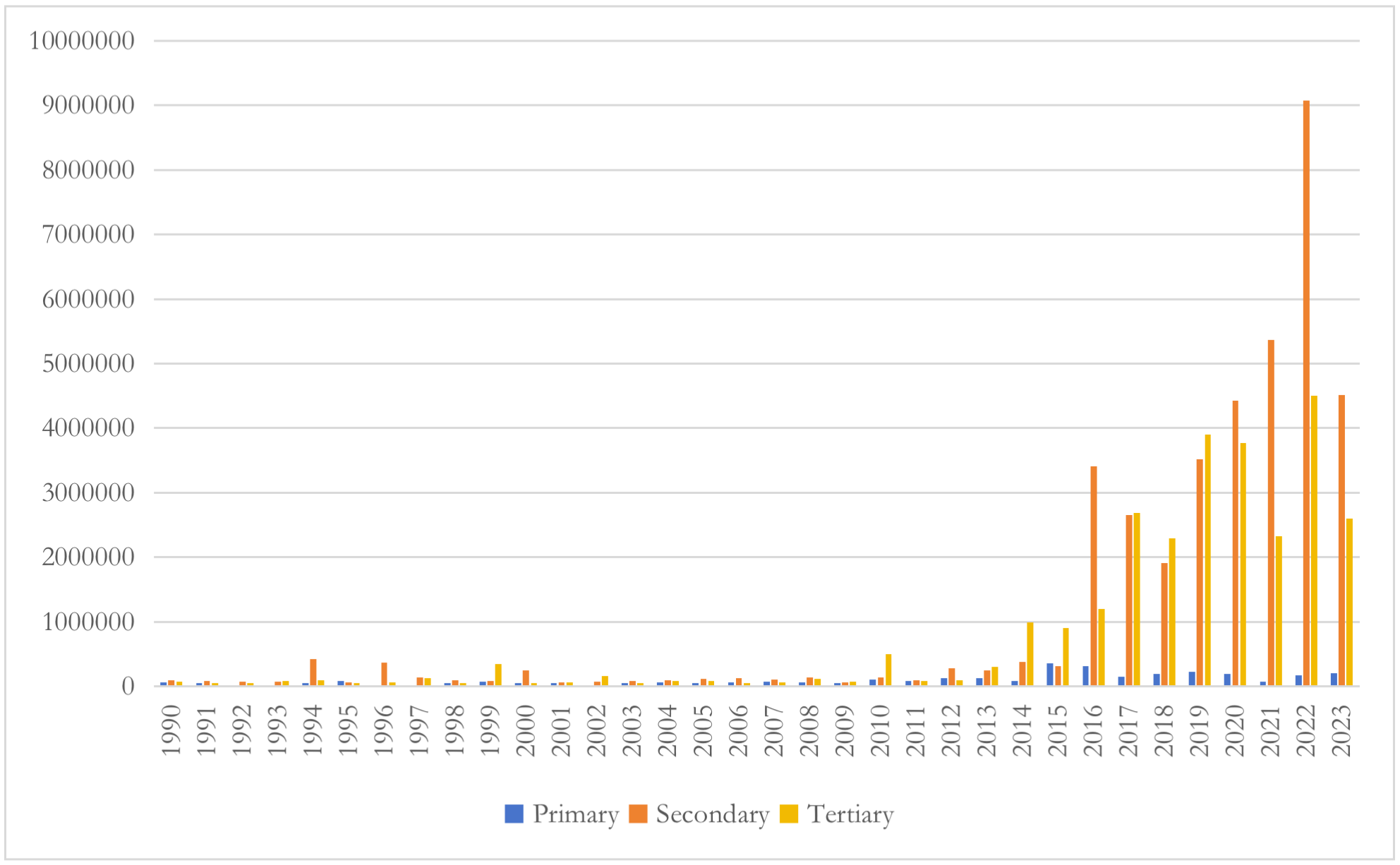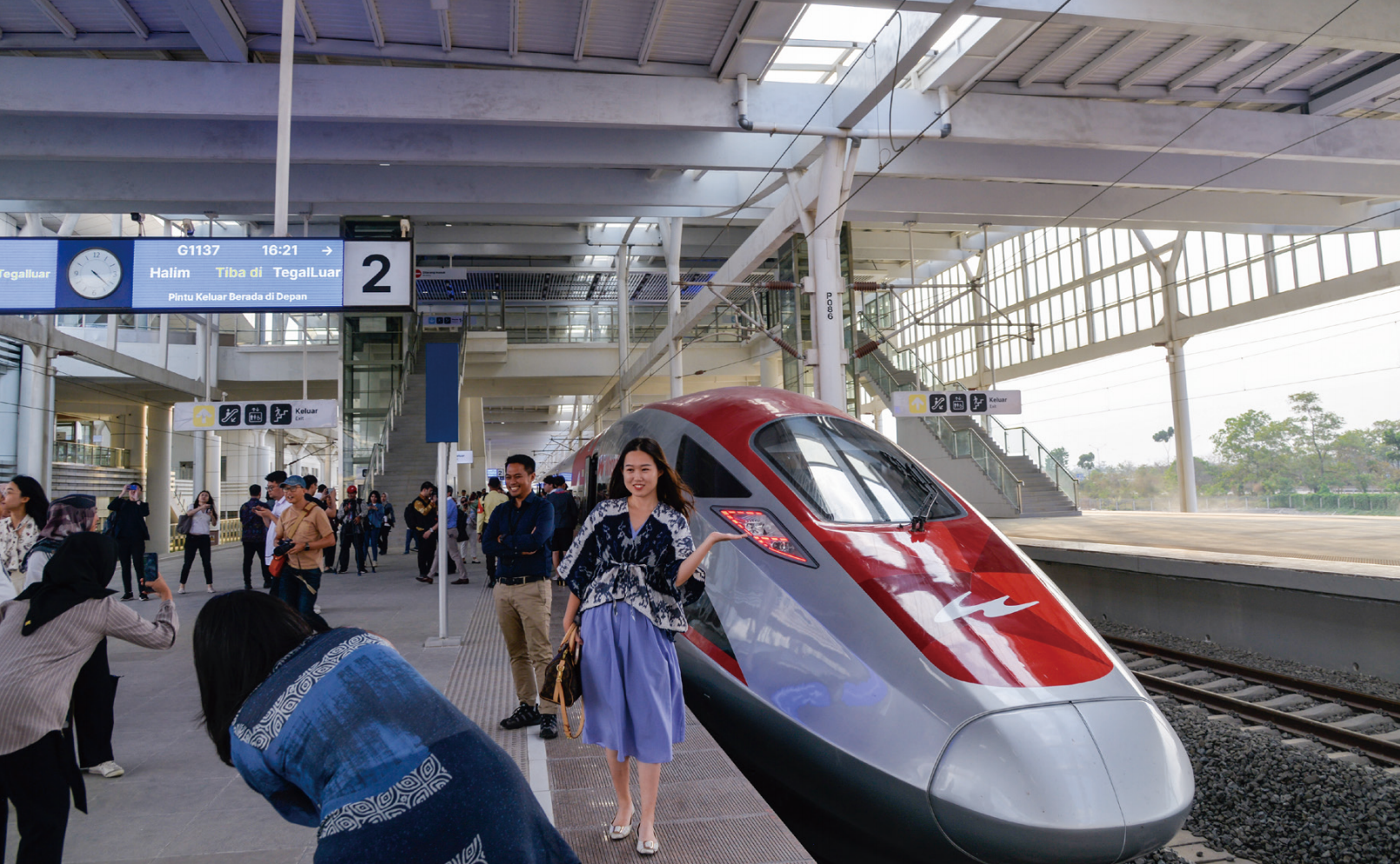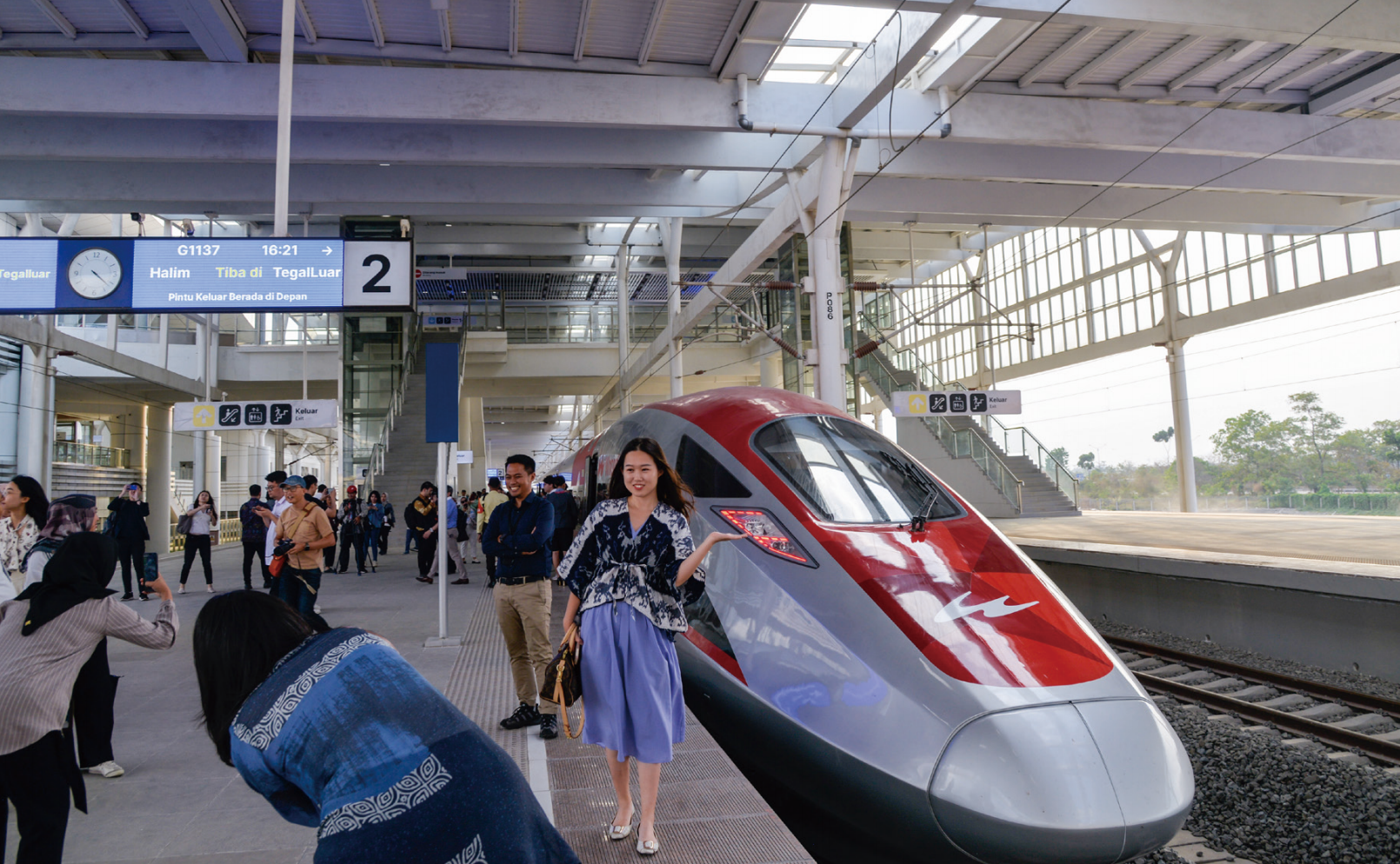On the occasion of the 10th anniversary of the Belt and Road Initiative (BRI), there are three ways to create a more future-proof cooperation between Indonesia and China. First, the two countries must join the global wave on higher quality and a greener economic partnership. Second, the two countries must enable more intensive interactions, better understandings, and stronger rapport between each other's populations. Finally, to complete stronger ties with China in economic dimension, it is equally important for the Indonesian public, as well as those in the neighboring ASEAN countries, to see China as a benevolent partner in political and security areas as well.
Author: Lina Alexandra, Head of the Department of International Relations, Centre for Strategic and
International Studies (CSIS), Indonesia
Muhammad Habib Abiyan Dzakwan, researcher at the Department of International Relations,
Centre for Strategic and International Studies (CSIS), Indonesia
A decade has passed since Chinese President Xi Jinping made the memorable speech on “the 21st Century Maritime Silk Road” at the Indonesian parliament. Since then, Indonesia has joined China as a member of the upper-middle-income group and even got forecasted (in the article The Path to 2075—Slow Global Growth, But Convergence Remains Intact, published on Goldman Sachs - Economics Research) to stand among the world’s largest economies by 2050. China would likely claim the leading economy status and Indonesia would follow closely at the fourth rank. This positive trajectory would not have been possible without an open and inclusive multilateral trading system, regional peace and stability, as well as the cordial relationships between the two countries. Building upon our reflections on Indonesia-China cooperation and the tenth anniversary of the Belt and Road Initiative (BRI), the authors will outline ways for the two countries to build a future-proof cooperation and endure the promising forecasts.
China from Multiple Angles
For Indonesia, there is no way to describe its relations with China only using one single frame. China is definitely one of the strongest partners of Indonesia. China brings a considerable amount of investment to Indonesia and is ranked as Indonesia’s largest trading partner. Exchanges between Chinese and Indonesian civilizations predated modern history, even though their official diplomatic relations got suspended for thirty years through the 1960s to the year of 1990. China is a pivotal partner for 10,000 MW of Indonesia’s electricity under former President Yudhoyono’s Fast-Track Program (FTP-1). China also acquired the same status in Indonesia’s COVID-19 vaccine development during the time when others were busy in hoarding supplies for their own people.
It is no doubt that the cordial relationship goes beyond bilateral level. For Indonesia, China has been a critical dialogue partner of the Association of Southeast Asian Nations (ASEAN) ever since the status was granted during the 29th ASEAN Ministerial Meeting in Jakarta. China consistently made significant milestones under Indonesia’s ASEAN chairmanships. In 2003, China established a Strategic Partnership for Peace and Prosperity with ASEAN and became the first dialogue partner to accede to the Treaty of Amity and Cooperation (TAC). In 2011, the ASEAN-China Centre was inaugurated in Beijing and the two entities agreed on the Guidelines to implement the Declaration on the Conduct of Parties (DOC) in the South China Sea. During the ASEAN chairmanship held by Indonesia in 2023, ASEAN-China once again adopted another guideline for Accelerating Negotiations for the Code of Conduct in the South China Sea, along with a new initiative on Enhancing Cooperation on E-commerce and a Joint Statement on Mutually Beneficial Cooperation under the ASEAN Outlook on the Indo-Pacific.
Multilateral settings are not an exception. Exchanges of diplomatic support also take place between the two leaders across various international fora. President Xi Jinping attended the 60th Anniversary of Bandung Conference in 2015—the first multilateral meeting organized by Joko Widodo’s administration following his inauguration in late 2014. Thanks to the in-person presence of President Xi Jinping and US President Joe Biden in Bali last year, President Joko Widodo’s G-20 leadership was spared from being heavily dominated by the Russian-Ukrainian conflict. It is also worth mentioning that Chinese Premiers never missed the East Asia Summit since this ASEAN-led platform's existence in 2005.
Likewise, Indonesia’s favorable opinion towards China’s multilateral Initiatives is something apparent. President Joko Widodo wasted no time to declare Indonesia as a co-founding member of the China-proposed Asian Infrastructure Investment Bank (AIIB) just a month after his inauguration, with total commitment around 3,360.7 million USD. He did not delegate his presence to someone else, during China’s organization on the 1st Belt and Road Forum for International Cooperation in 2017, the High-Level Dialogue on Global Development in 2022, and the FISU World University Games in 2023. It is not rocket science to see a good rapport between the two leaders and countries. To be honest, it is not something common for President Joko Widodo, who spends most of his administration at home rather than travelling abroad.
BRI as A Momentum
Undoubtedly, the Belt and Road Initiative is a significant milestone in this positive trajectory. Despite being commenced a year before President Joko Widodo officially governed, it is under his administration that Indonesians have started to reap benefits from the BRI. Earlier in October, the President finally launched the long-awaited Jakarta-Bandung High Speed Rail (HSR), or now being named as WHOOSH. Public enthusiasm is high in welcoming this BRI flagship project. Fifteen-thousand people joined the early operation in the first week of October this year. People have more options now to travel between the two mega cities in less than an hour. Indonesia’s public works sector has also learned a new method of girder erection and the techonology of tunnel construction from the HSR project.
Chart 1

The Morowali Industrial Park (IMIP) is another BRI flagship project that inspires a new mindset among Indonesian officials. Thanks to Chinese investment and technology in the IMIP, Indonesia will not have to export its critical minerals endowment in raw forms. The country can increase the added value of its exported commodities and expand more job opportunities surrounding the Industrial Park. Chart 1 shows that China’s investment goes beyond the IMIP and continues to surge since 2013. Significant shares of the investment, followed by the tertiary and primary sector, concentrated on the secondary sector including mineral smelting businesses. In 2022, China’s investment in the secondary sector alone even reached more than nine billion USD, which was doubled than the last year.
Chart 2

Not only in the aspects of investment and mobility, the BRI also offers Indonesia an opportunity to improve its trade relations with China. “Two Countries Twin Parks” (TCTP) is one of the prime mechanisms. After being inaugurated in 2021, the TCTP has enabled Indonesian enterprises to join China’s seafood industrial chain and export more products to China. Around 1,600 tons of Indonesia’s frozen prawns arrived in Fujian Province in this August as the early harvest from this scheme. Another way to understand the TCTP is through its potential in reducing Indonesia’s negative trade balance with China. Chart 2 shows that the deficit lasted for more than five years since the BRI was introduced. The gap began to significantly narrow from 14,467 million USD in 2019 to 5,818 million USD in 2020. Although a slight surplus has been recorded in 2022, it is unclear to what extent the TCTP contributes to this trend. One thing for sure is that the BRI has served as a momentum for Indonesia to reconfigure its development path.
The World is Different
As much as the BRI has contributed to Indonesia’s development and has strengthened the rapport between Indonesian-Chinese leaders over the past decade, nonetheless it is the time to evaluate whether the existing cooperation still matches emerging challenges. The world today is unlike the world when the BRI was launched in 2013. Multilateral trading system has been broken into fragmented minilateral supply chains and trade agreements. Efficiency no longer constitutes the primary consideration of economic cooperation and investment flow. The BRI’s role seems now to be clouded, if not completely replaced, by geopolitical thoughts and mandatory compliance to Environmental, Social, and Governance (ESG) standards. The prevailing jargons are decoupling, de-risking, and de-carbonization.

Whereas Indonesia and China do not have to follow down to the geopolitical path; the two countries must strive for higher quality in industrial, trade, and investment partnerships through and beyond the BRI. In the Third Belt and Road Forum for International Cooperation held just in this October, President Xi Jinping already made clear about this aspiration with the eight major steps that would be pursued by China ahead, to support the high-quality development of the BRI. Among others, these steps include promoting green development and integrity-based cooperation. The Indonesian side also reciprocates this sentiment. President Jokowi mentioned that the future of the BRI must let its partner countries develop the sense of ownership towards the projects, resources of domestic labors, local components, as well as not burdening their fiscal conditions. At the moment, the BRI has yet become that kind of platform, to a large extent, that provides assurance for the partner countries to truly enjoy the benefits without string attached.
That is, the enforcement of environmental and social safeguards in the Morowali Industrial Park could be much improved. The use of coal-fired power plants by Chinese companies working in mineral smelting business is still prevailing. Most of them are off-grid and cannot be properly monitored. Some companies also need to have due regards to their operations in the aspects of occupational hazards and social risks.
Moreover, social interactions are hampered by the lack of common operational language in the Park. Not only Chinese workers there do not necessarily speak Indonesian, but Indonesian workers do not have the ability to speak Chinese as well. If these shortcomings were not addressed properly, it would be difficult for outputs coming from this Industrial Park to be competitive in Western market.
Future-Proof Cooperation
To conclude this article, there are three ways to create a more future-proof cooperation between Indonesia and China. First, the two countries must join the global wave on higher quality and a greener economic partnership. Second, the two countries must enable more intensive interactions, better understandings, and stronger rapport between each other’s populations. Finally, to complete stronger ties with China in economic dimension, it is equally important for the Indonesian public, as well as those in the neighboring ASEAN countries, to see China as a benevolent partner in political and security areas as well. To see China, which significantly implicates to the region as a rational and responsible global player amidst a heightening of geopolitical rivalries, would certainly be helpful for China to foster a profound strategic partnership with countries in the Southeast Asia region.
(The article has been edited,This article was published in the November 2023 issue of Bauhinia Magazine)
https://res.youuu.com/zjres/2023/11/2/BE5Fe6q4MwzFEf2lHyG0WHDWCfmOuRZ7yIz.png











掃描二維碼分享到手機














